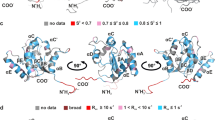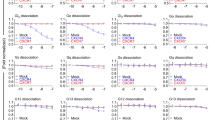Abstract
The importance of immunoreceptor tyrosine-based activation motif (ITAM)-coupled receptors in modulating signalling pathways downstream of other types of receptor is well established, but the mechanisms underlying this modulation are not known. Recent data suggest that calcium-dependent signalling downstream of ITAM-coupled receptors regulates the amplitude and functional outcomes of cytokine and TLR signalling. In this Opinion article, I describe a model whereby the intensity of ITAM-dependent signalling and the balance of calcium signals relative to other ITAM-mediated signalling pathways determines whether cellular responses to cytokines and TLR ligands are increased or inhibited. This model describes mechanisms that explain how ITAM-coupled receptors regulate heterologous signalling pathways.
This is a preview of subscription content, access via your institution
Access options
Subscribe to this journal
Receive 12 print issues and online access
$209.00 per year
only $17.42 per issue
Buy this article
- Purchase on Springer Link
- Instant access to full article PDF
Prices may be subject to local taxes which are calculated during checkout




Similar content being viewed by others
References
Romeo, C., Amiot, M. & Seed, B. Sequence requirements for induction of cytolysis by the T cell antigen/Fc receptor ζ chain. Cell 68, 889–897 (1992).
C. L. & Lowell, C. A. The expanding role for ITAM-based signaling pathways in immune cells. Sci. STKE 2007, re2 (2007).
Ravetch, J. V. & Lanier, L. L. Immune inhibitory receptors. Science 290, 84–89 (2000).
Healy, J. I. et al. Different nuclear signals are activated by the B cell receptor during positive versus negative signaling. Immunity 6, 419–428 (1997).
Sloan-Lancaster, J., Shaw, A. S., Rothbard, J. B. & Allen, P. M. Partial T cell signaling: altered phospho-ζ and lack of zap70 recruitment in APL-induced T cell anergy. Cell 79, 913–922 (1994).
Barrow, A. D. & Trowsdale, J. You say ITAM and I say ITIM, let's call the whole thing off: the ambiguity of immunoreceptor signalling. Eur. J. Immunol. 36, 1646–1653 (2006).
Hamerman, J. A. & Lanier, L. L. Inhibition of immune responses by ITAM-bearing receptors. Sci. STKE 2006, re1 (2006).
Turnbull, I. R. & Colonna, M. Activating and inhibitory functions of DAP12. Nature Rev. Immunol. 7, 155–161 (2007).
Underhill, D. M. & Goodridge, H. S. The many faces of ITAMs. Trends Immunol. 28, 66–73 (2007).
Klesney-Tait, J., Turnbull, I. R. & Colonna, M. The TREM receptor family and signal integration. Nature Immunol. 7, 1266–1273 (2006).
Tassiulas, I. et al. Amplification of IFN-α-induced STAT1 activation and inflammatory function by Syk and ITAM-containing adaptors. Nature Immunol. 5, 1181–1189 (2004).
Wang, L. et al. 'Tuning' of type I interferon-induced Jak-STAT1 signaling by calcium-dependent kinases in macrophages. Nature Immunol. 9, 186–193 (2008).
Kanamaru, Y. et al. Inhibitory ITAM signaling by FcαRI-FcRγ chain controls multiple activating responses and prevents renal inflammation. J. Immunol. 180, 2669–2678 (2008).
Pasquier, B. et al. Identification of FcαRI as an inhibitory receptor that controls inflammation: dual role of FcRγ ITAM. Immunity 22, 31–42 (2005).
Pinheiro da Silva, F. et al. CD16 promotes Escherichia coli sepsis through an FcRγ inhibitory pathway that prevents phagocytosis and facilitates inflammation. Nature Med. 13, 1368–1374 (2007).
Kang, Y. J. et al. Calcineurin negatively regulates TLR-mediated activation pathways. J. Immunol. 179, 4598–4607 (2007).
Bezman, N. & Koretzky, G. A. Compartmentalization of ITAM and integrin signaling by adapter molecules. Immunol. Rev. 218, 9–28 (2007).
Borde, M., Barrington, R. A., Heissmeyer, V., Carroll, M. C. & Rao, A. Transcriptional basis of lymphocyte tolerance. Immunol. Rev. 210, 105–119 (2006).
Avraham, H., Park, S. Y., Schinkmann, K. & Avraham, S. RAFTK/Pyk2-mediated cellular signalling. Cell Signal 12, 123–133 (2000).
Hook, S. S. & Means, A. R. Ca2+/CaM-dependent kinases: from activation to function. Annu. Rev. Pharmacol. Toxicol. 41, 471–505 (2001).
Dolmetsch, R. E., Lewis, R. S., Goodnow, C. C. & Healy, J. I. Differential activation of transcription factors induced by Ca2+ response amplitude and duration. Nature 386, 855–858 (1997).
Gallo, E. M., Cante-Barrett, K. & Crabtree, G. R. Lymphocyte calcium signaling from membrane to nucleus. Nature Immunol. 7, 25–32 (2006).
Mocsai, A. et al. The immunomodulatory adapter proteins DAP12 and Fc receptor γ-chain (FcRγ) regulate development of functional osteoclasts through the Syk tyrosine kinase. Proc. Natl Acad. Sci. USA 101, 6158–6163 (2004).
Hamerman, J. A. et al. Cutting Edge: inhibition of TLR and FcR responses in macrophages by triggering receptor expressed on myeloid cells (TREM)-2 and DAP12. J. Immunol. 177, 2051–2055 (2006).
Turnbull, I. R. et al. Cutting Edge: TREM-2 attenuates macrophage activation. J. Immunol. 177, 3520–3524 (2006).
Chu, C. L. et al. Increased TLR responses in dendritic cells lacking the ITAM-containing adapters DAP12 and FcRγ. Eur. J. Immunol. 38, 166–173 (2008).
Hamerman, J. A., Tchao, N. K., Lowell, C. A. & Lanier, L. L. Enhanced Toll-like receptor responses in the absence of signaling adaptor DAP12. Nature Immunol. 6, 579–586 (2005).
Heissmeyer, V. et al. Calcineurin imposes T cell unresponsiveness through targeted proteolysis of signaling proteins. Nature Immunol. 5, 255–265 (2004).
Abtahian, F. et al. Evidence for the requirement of ITAM domains but not SLP-76/Gads interaction for integrin signaling in hematopoietic cells. Mol. Cell Biol. 26, 6936–6949 (2006).
Mocsai, A. et al. Integrin signaling in neutrophils and macrophages uses adaptors containing immunoreceptor tyrosine-based activation motifs. Nature Immunol. 7, 1326–1333 (2006).
Zou, W. et al. Syk, c-Src, the αvβ3 integrin, and ITAM immunoreceptors, in concert, regulate osteoclastic bone resorption. J. Cell Biol. 176, 877–888 (2007).
Dhodapkar, K. M. et al. Selective blockade of the inhibitory Fcγ receptor (FcγRIIB) in human dendritic cells and monocytes induces a type I interferon response program. J. Exp. Med. 204, 1359–1369 (2007).
Hu, X. et al. Sensitization of IFN-γ Jak–STAT signaling during macrophage activation. Nature Immunol. 3, 859–866 (2002).
Pricop, L. et al. Differential modulation of stimulatory and inhibitory Fcγ receptors on human monocytes by TH1 and TH2 cytokines. J. Immunol. 166, 531–537 (2001).
Tridandapani, S. et al. Regulated expression and inhibitory function of FcγRIIb in human monocytic cells. J. Biol. Chem. 277, 5082–5089 (2002).
Takayanagi, H. Osteoimmunology: shared mechanisms and crosstalk between the immune and bone systems. Nature Rev. Immunol. 7, 292–304 (2007).
Lee, S. H., Kim, T., Jeong, D., Kim, N. & Choi, Y. The Tec family tyrosine kinase Btk regulates RANKL-induced osteoclast maturation. J. Biol. Chem. 283, 11526–11534 (2008).
Shinohara, M. et al. Tyrosine kinases Btk and Tec regulate osteoclast differentiation by linking RANK and ITAM signals. Cell 132, 794–806 (2008).
Nimmerjahn, F. & Ravetch, J. V. Fcγ receptors as regulators of immune responses. Nature Rev. Immunol. 8, 34–47 (2008).
Vivier, E., Nunes, J. A. & Vely, F. Natural killer cell signaling pathways. Science 306, 1517–1519 (2004).
Turnbull, I. R. et al. DAP12 (KARAP) amplifies inflammation and increases mortality from endotoxemia and septic peritonitis. J. Exp. Med. 202, 363–369 (2005).
Brown, G. D. et al. Dectin-1 mediates the biological effects of β-glucans. J. Exp. Med. 197, 1119–1124 (2003).
Gantner, B. N., Simmons, R. M., Canavera, S. J., Akira, S. & Underhill, D. M. Collaborative induction of inflammatory responses by dectin-1 and Toll-like receptor 2. J. Exp. Med. 197, 1107–1117 (2003).
Rogers, N. C. et al. Syk-dependent cytokine induction by Dectin-1 reveals a novel pattern recognition pathway for C type lectins. Immunity 22, 507–517 (2005).
Mosser, D. M. The many faces of macrophage activation. J. Leukoc. Biol. 73, 209–212 (2003).
Lee, I. H., Li, W. P., Hisert, K. B. & Ivashkiv, L. B. Inhibition of interleukin 2 signaling and signal transducer and activator of transcription (STAT)5 activation during T cell receptor-mediated feedback inhibition of T cell expansion. J. Exp. Med. 190, 1263–1274 (1999).
Zhu, J. et al. Transient inhibition of interleukin 4 signaling by T cell receptor ligation. J. Exp. Med. 192, 1125–1134 (2000).
Du, Z. et al. Selective regulation of IL-10 signaling and function by zymosan. J. Immunol. 176, 4785–4792 (2006).
Ji, J. D. et al. Inhibition of interleukin 10 signaling after Fc receptor ligation and during rheumatoid arthritis. J. Exp. Med. 197, 1573–1583 (2003).
Du, Z. et al. Inhibition of IFN-α signaling by a PKC- and protein tyrosine phosphatase SHP-2-dependent pathway. Proc. Natl Acad. Sci. USA 102, 10267–10272 (2005).
Yoshimura, A., Naka, T. & Kubo, M. SOCS proteins, cytokine signalling and immune regulation. Nature Rev. Immunol. 7, 454–465 (2007).
Ahmed, S. T. & Ivashkiv, L. B. Inhibition of IL-6 and IL-10 signaling and Stat activation by inflammatory and stress pathways. J. Immunol. 165, 5227–5237 (2000).
Ahmed, S. T., Mayer, A., Ji, J. D. & Ivashkiv, L. B. Inhibition of IL-6 signaling by a p38-dependent pathway occurs in the absence of new protein synthesis. J. Leukoc. Biol. 72, 154–162 (2002).
Bode, J. G. et al. TNF-α induces tyrosine phosphorylation and recruitment of the Src homology protein-tyrosine phosphatase 2 to the gp130 signal-transducing subunit of the IL-6 receptor complex. J. Immunol. 171, 257–266 (2003).
Fischer, P. et al. The role of the inhibitors of interleukin-6 signal transduction SHP2 and SOCS3 for desensitization of interleukin-6 signalling. Biochem. J. 378, 449–460 (2004).
Radtke, S. et al. Pro-inflammatory cytokines restrict IL-6 signaling through p38/MK2-mediated internalization and degradation of gp130. Cytokines in Health and Disease Abstract 223 [http://www.cytokines2007.org/abstracts2.pdf]. 15th Annual Meeting of the International Cytokine Society. (2007).
Sengupta, T. K., Schmitt, E. M. & Ivashkiv, L. B. Inhibition of cytokines and JAK-STAT activation by distinct signaling pathways. Proc. Natl Acad. Sci. USA 93, 9499–9504 (1996).
Kalliolias, G. & Ivashkiv, L. B. IL-27 activates human monocytes via STAT1 and suppresses IL-10 production but the inflammatory functions of IL-27 are abrogated by TLRs and p38. J. Immunol. 180, 6325–6333 (2008).
Park, J. H. et al. 'Coreceptor tuning': cytokine signals transcriptionally tailor CD8 coreceptor expression to the self-specificity of the TCR. Nature Immunol. 8, 1049–1059 (2007).
Park-Min., K. H. et al. FcγRIII-dependent inhibition of interferon-γ responses mediates suppressive effects of intravenous immune globulin. Immunity 26, 67–78 (2007).
Ochi, S. et al. Pathological role of osteoclast costimulation in arthritis-induced bone loss. Proc. Natl Acad. Sci. USA 104, 11394–11399 (2007).
Acknowledgements
I thank M. Nakamura for discussions and S. Goldring and X. Hu for critical review of the manuscript. This work was supported by grants from the National Institutes of Health.
Author information
Authors and Affiliations
Ethics declarations
Competing interests
The author declares no competing financial interests.
Related links
Rights and permissions
About this article
Cite this article
Ivashkiv, L. A signal-switch hypothesis for cross-regulation of cytokine and TLR signalling pathways. Nat Rev Immunol 8, 816–822 (2008). https://doi.org/10.1038/nri2396
Issue Date:
DOI: https://doi.org/10.1038/nri2396
This article is cited by
-
Spatial organization of FcγR and TLR2/1 on phagosome membranes differentially regulates their synergistic and inhibitory receptor crosstalk
Scientific Reports (2021)
-
Glial and Neuroimmune Mechanisms as Critical Modulators of Drug Use and Abuse
Neuropsychopharmacology (2017)
-
A novel role for β2-microglobulin: a precursor of antibacterial chemokine in respiratory epithelial cells
Scientific Reports (2016)
-
A role for the ITAM signaling module in specifying cytokine-receptor functions
Nature Immunology (2014)
-
A mechanism of immunoreceptor tyrosine-based activation motif (ITAM)-like sequences in the capsid protein VP2 in viral growth and pathogenesis of Coxsackievirus B3
Virus Genes (2012)



